People who have never observed tortoises term them as boring pets, but the truth is that tortoises are fun and fascinating pets.
And if you disagree with this, ask yourself why over 350,000 homeowners in America keep tortoises as pets in their homes?
However, deciding to bring home this slow land dweller is a big commitment, and you need to be prepared to take care of it for a lifetime. Speaking of tortoise care, different tortoises need varying levels of care, with some being more straightforward to take care of than others.
In this article, we discuss the best tortoise breeds for beginners. But before then, there are different things you should keep in mind before purchasing a tortoise.
What to Know Before Buying a Tortoise
For first-time buyers, it can be intimidating to go to a pet store. After all, there is not plenty of information about caring for tortoises and how to choose a pet tortoise compared to the information available for other common pets such as cats and dogs.
That’s why we’re here to help. Tortoises can make fun pets for your family if well taken care of. Here are vital things to know before making your first purchase:
1. Tortoises and Turtles Are Different
Many people use tortoise and turtle interchangeably, not knowing the two are not the same. The fact is that whereas all tortoises are turtles, all turtles are not tortoises. Confusing, right?
Well, here are quick differences between the two:
| Tortoise | Turtle | |
| Natural habitat | Solely lives inland | Some are aquatic, while others are semi-aquatic |
| Shell | Most have dome-shaped shells | Most have flat, streamlined shells |
| Lifespan | Can live between 50 and 100 years with good care | Have a lifespan of 20-40 years |
| Diet | They are herbivores and thus prefer fresh foods | Omnivorous |
These may not seem like apparent differences, but they do help when it comes to determining what to feed your pet and creating its habit.
2. Tortoise Diet
As we pointed above, tortoises are herbivorous, which means you’ll need to prepare a plant-based diet. Remember that they eat fresh vegetables such as collard greens, peppers, and kale.
Also, you can give them fruits such as apples and grapes, but these should not be food choices – they should be given as treats. To cater to their calcium needs, you should provide the tortoises with calcium supplements once a week. Stick with a plant-based diet, and your tortoise will have a happy life.
3. Habitat
Ideally, you should give your tortoise a habitat that matches its natural, wild environment as much as possible. That’s why you should keep them outdoor if possible. However, if you don’t have an outdoor enclosure, an indoor solution is still acceptable.
Indoors, invest in a wooden tortoise table that measures 30 inches by 18 inches by 6 inches for tortoises under five years and 4 feet by 2 feet by 8 feet for adult tortoises.
A tortoise enclosure should be spacious to give your pet plenty of space to roam around.
When indoors, you need to include a UV and heat bulb. Ensure your pet tortoise gets plenty of light. UVA light helps stabilize tortoise’s biological clock and processes, while UVB light helps their body absorb and process calcium.
In addition, there should be a heat bulb to keep their enclosure warm since tortoises are poikilotherms, which means they rely on the external environment to regulate their body temperatures.
Keep a hot spot on one side of the enclosure at 95 degrees Fahrenheit and another cooler area at 75 degrees Fahrenheit. Also, maintain the nighttime temperature at around 60 degrees Fahrenheit. Make sure to replace UVB bulbs every 8-12 months.
Failure to provide UV bulbs may cause metabolic bone disease, with symptoms such as bowed legs, loss of appetite, softshell, limping, and difficulty walking. Low levels of calcium also cause depression, hind end weakness, seizures, and death in tortoises.
4. Know Your Species
Before purchasing a tortoise, it’s essential to know its species. This is because different species require different care and grow into different sizes. When buying, tortoises come as juveniles, and it may not hit you how big it’ll get as an adult. That’s why you need to research different tortoise species before buying one.
Best Pet Tortoises
Now that you are aware of what you should consider when buying a pet tortoise, you’re in a better position to know the species that best suits you. Here’s what you need to know about the most popular species that you can keep as pets.
Here are the easiest tortoises you can keep as pets:
1. The Russian Tortoise
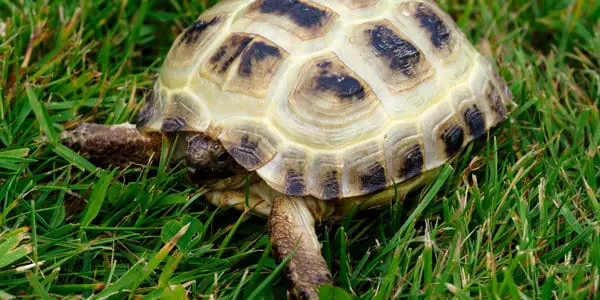
Quick Facts
Ideal for: Beginners
Scientific Name: Testudo Horsfield
Lifespan: Up to 50 years when taken care of well
Average Adult Size: 6-8 inches long
Diet: Herbivore
UVB Lighting: A must-have
There is a reason why the Russian tortoise is a popular choice among many homeowners – it’s because they remain small, are beautiful pets, and tend to be pretty inexpensive. Also, they’re easy to care for and quickly bond with their new owner.
The Russian tortoise, just as its name implies, is native to Russia. It has other names, including the Afghan, the central Asian, the four-toed tortoise, the Horsefield’s tortoise, and the Steppe.
These names indicate their origin -Afghanistan, Pakistan, Iran, or Russia. All these parts bear one thing in common – they are in elevated regions. The Russian tortoise likes to burrow and hibernate, especially during winter, and thus you have to provide it with favorable things to hibernate when winter comes calling.
It can live for over 40 years and has an active, fun personality. The tortoise is small and only reaches six to eight inches at maturity, which is why they are a popular choice among pet stores.
The Russian tortoise is a flexible pet and can live in an outdoor enclosure as long as you give it the needed things for burrowing and hibernating – they can protect themselves from the extremes of the weather. However, do not leave it outside without hibernating tools during cooler temperatures.
The outdoor pen should have at least one foot-high walls to keep the tortoise from climbing out and wandering away. Also, the fence barrier should be six inches deeper to prevent them from burrowing out.
In terms of size, the Russian tortoise male can reach up to six inches, with their female counterparts growing to eight inches. Making husbandry for them is simply due to their small size. An enclosure measuring two by three feet can be ideal for one adult tortoise. Of course, the larger the enclosure, the better.
However, they still need a solid bin with basic requirements such as UVB light, basking spot, and proper foods. In addition, provide a shallow water dish for them to soak. In addition, sometimes, bring the tortoise outside for some natural UVB from the sun and for fresh air.
We can say a lot about these torts, but we have more torts to discuss in this guide. The information we give here is only meant to provide you with an idea of what each species needs.
2. The Greek Tortoise
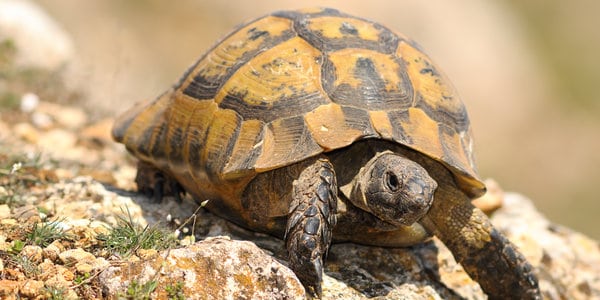
Quick Facts
Common Names: Mediterranean Spur-thighed tortoise, Spur-thighed tortoise
Good for: Beginners
Scientific Name: Testudo graeca
Average Lifespan: Can live up to 125 years
Adult Size: Can grow up to five to eight inches
Diet: Herbivorous diet including weed and herbs
UVB Lighting: Must be provided
Also known as spur-thighed tortoise, the Greek tortoise is readily available and primarily comes from the Mediterranean and parts of Africa and Europe.
Averagely, this species can grow between five and eight inches long, although some female subspecies can grow up to 11 inches. In the natural habitat, they have a lifespan of about twenty years, but they can live for over 100 years in captivity. Therefore, be ready for your pet to outlive you. Due to this, many people include them in their wills to ensure that their favorite pets are cared for when they pass on.
To care for this tortoise, make sure to have three feet by six feet enclosure made of either opaque plastic or plywood for a single adult Greek tortoise. Ensure the enclosure does not have a see-through fence as this tortoise will have difficulty understanding barriers.
If you’re to pet two male Greek tortoises, you should keep them in separate enclosures as they are likely to fight, especially if there is a female tortoise nearby. If you have an expansive space, larger enclosures are better. Like many tortoises and reptiles, avoid handling the Greek tortoise too often as it can become stressed.
If you can find an outdoor enclosure, the better as they are better housed in dry, warm outdoor exposures. These tortoises can tolerate up to 75 to 85 degrees Fahrenheit and night temperatures of 65 degrees.
When buying the Greek Tortoise, avoid wild-caught ones as they are harder to care for. Instead, go for captive-bred ones.
In terms of diet, feed them with grass and hay as their staple diet and give them leafy vegetables and fibrous fruits such as pears and apples once in a while. You can supplement with commercial tortoise food to help them grow faster and gain weight.
The Greek tortoises are curious creatures and like to explore their enclosure and interact with their owners. You’ll find them active during the day when grazing.
Thanks to their small size and active nature, they make excellent pets for both experienced and novice keepers.
3. The Indian Star Tortoise
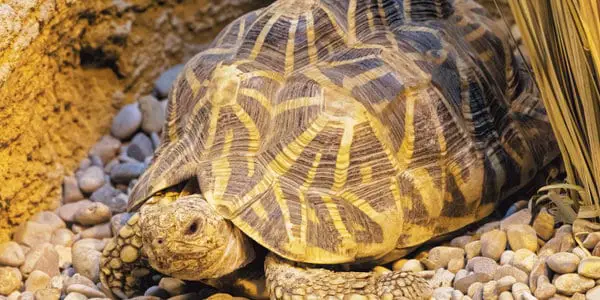
Quick Facts
Common Names: Star tortoise
Ideal for: Intermediate pet keepers
Scientific Name: Geochelone elegans
Lifespan: 30 to 80 years
Adult Size: Can attain a length of 6 to 15 inches
Diet: Herbivorous diet that includes greens, grass, and vegetables
UVB Lighting: Should be provided if the enclosure is indoors
The Indian star tortoises are adorable thanks to their attractive star-shaped markings and make good pets thanks to their friendly nature. However, their gorgeous patterns make them pricier.
This medium-sized tortoise is native to Sri Lanka, Pakistan, and India, where there are scrub forests. Their name comes from the star-like design of their carapace, and their attractive nature makes them the most common tortoise species kept in captivity.
Make sure to buy a captive-bred hatchling instead of getting a wild-caught one, as it’s illegal. The wild Indian star tortoise has become a threatened species due to over-collection.
The lifespan of this species can vary greatly depending on how you care for them, but they can live between thirty and eighty years, sometimes even longer. Therefore, be ready to have a lifetime friend.
Male Indian star tortoises can grow up to five to six inches, while female counterparts can grow up to eight inches.
Enclosure for the Indian star tortoise is quite similar to other small tortoise species. Three feet by 2 feet enclosure is the smallest enclosure you can have for this breed. The size can house one adult-sized Indian star tortoise indoors. Make sure to use opaque materials, as this tortoise can have a hard time knowing where boundaries are, especially when you have see-through materials.
Also, make sure to have a UVB bulb in their basking spot to enable them to grow stronger bones and hard shells. The basking spot should be one-half of their enclosure. In addition, have a heat bulb that maintains 80 to 90 degrees Fahrenheit in the basking spot.
Like most other tortoises, you should care for this tortoise by feeding it with leafy hay and grasses as well as vegetables and herbs. Give fruits sparingly to spice its diet. They require a high-calcium, high-fiber diet.
Star tortoises thrive well in the dry cold season and humid hot season. Unlike most turtle species, the Indian star tortoise can co-exist without conflict, even when females are in the enclosure.
Another benefit of these tortoises is their inability to burrow or climb, which means they cannot escape easily. An 8-inch tall wall will be sufficient to keep them in your enclosure.
4. The African Pancake Tortoise
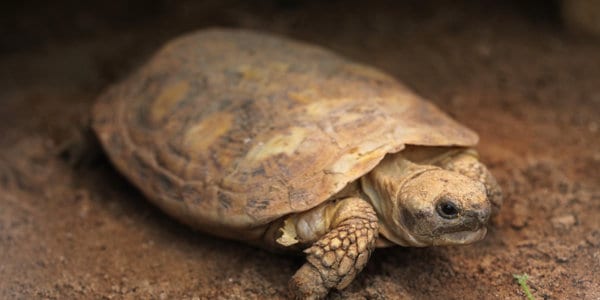
Quick Facts
Common Names: Crevice tortoise, Tonier’s tortoise, and softshell tortoise
Scientific Name: Malacochersus tornieri
Ideal for: More experienced keepers
Average Lifespan: 35 years but can live up to 50 years in captivity
Adult Size: Can grow up to 6 or 7 inches
Diet: Herbivore diet comprising of hay and succulent vegetables
African pancake tortoises are small, with adults growing up to seven inches in length and weighs around one pound. Unlike other tortoises with hardened shells, which protect from predators, the African pancake tortoise has a softer shell because they rely on their speed and ability to hide in tight crevices.
In the wild, they like dry, hot habitats, so they are native to Tanzania, Kenya, and Zimbabwe. They are known to be agile climbers, which is why you need to secure their enclosure; otherwise, they will escape.
Like other tortoise species, the pancake tortoise thrives outdoors but remember that it’s vulnerable to cats, rats, raccoons, and dogs due to its softshell. Therefore, make sure to supervise their sunbathing time.
These turtles can live between 35 and 55 years, although there’s limited information on this breed regarding the life expectancy range.
Their population has declined in the wild due to over-collection and thus are almost becoming an endangered species. Therefore, ensure that you always buy one from a reputable breeder. You may need to book in advance since African pancake tortoises have a slow reproductive rate because they don’t lay many eggs compared to other tortoise breeds. Their colors vary in shades of light browns and yellows.
We’ve mentioned that the pancake tortoise likes to climb, and thus it can be tricky to keep them in an open enclosure. Therefore, have a screen top on their enclosure to ensure the tortoise doesn’t climb out. If you’re wondering how good of a climber a pancake tortoise is, just know that it can climb a vertical wall.
Invest in a tortoise table if you’re looking to keep this tortoise indoors – the more the space, the better. The lighting and heating requirement for the pancake tortoise is quite similar to others. Maintain the temperature in the basking spot at 90 to 100 degrees Fahrenheit. Ensure temperatures in its enclosure don’t fall below 70 degrees Fahrenheit.
Fun fact about the African pancake tortoise: As hatchlings, these tortoises have a domed shell, but as they grow, their shell flattens, hence their name pancake tortoise. The shell is pretty lightweight, which explains why they are the fastest tortoise breed. This comes with the downside that they can easily escape from their enclosure.
5. Egyptian Tortoise
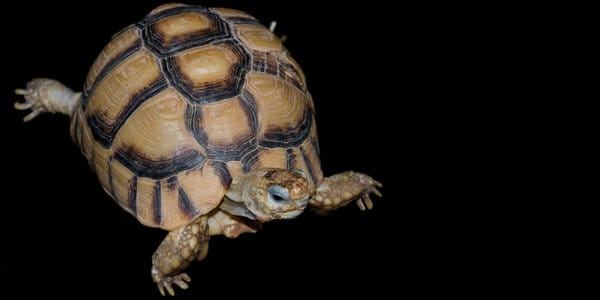
Quick Facts
Common Names: Leith’s tortoise, Kleinmann’s tortoise
Scientific Name: Testudo Kleinmanni
Ideal for: Experienced pet owners due to their specialized needs
Lifespan: 70-100 years
Adult Size: 5 inches
Kleinmann’s tortoise, popularly known as the Egyptian tortoise, is native to Libya and Egypt. They are now considered critically endangered due to wild exportation.
Thankfully, some reputable breeders have captive-bred hatchlings for pet owners who would like to keep it as a pet. The Egyptian tortoise is a highly sought-after pet due to its petite size as they rarely grow longer than five inches and weigh no more than 400 grams.
Despite their tiny bodies, the Egyptian tortoise still needs ample space in their enclosure. You can keep them indoors on a tortoise table measuring 2 feet by two feet.
Natively, they are desert-dwellers, and thus their enclosure should be kept dry with temperatures ranging from 75 degrees Fahrenheit and 90 degrees Fahrenheit. They aren’t known to be burrowers, and thus you don’t need to reinforce their barriers.
However, despite their bodies being accustomed to desert areas, the Egyptian tortoise tends to experience dehydration fast. As such, make sure to soak them in shallow waters several times a week, even when you have kept them in their enclosure.
In terms of diet, give the Egyptian tortoise leafy greens. Avoid fruits and animal protein. You can occasionally feed them a commercial tortoise diet, but if possible, avoid it as it tends to make them add too much weight.
Egyptian tortoises can live for about 70 to 100 years and reach breeding maturity at five years. However, once they hit three hundred grams, they are generally mature for breeding – so no need to keep track of their age too closely.
Pet owners like the Egyptian tortoise due to its small size, which explains why it is one of the most preferred pet tortoises. Taking care of the hatchlings is challenging; despite the species being from harsh deserts, their babies are delicate.
Maintain the heat source at between 75 to 85 degrees Fahrenheit and provide UVB light. In addition, have some cool hides where the young torts can hide to cool off their bodies.
Overall, these little guys are adorable and make great pets once they grow into adults. They are only delicate during the hatchling stage, which is why they are best taken care of by experienced tortoise keepers.
6. Hermann’s Tortoise
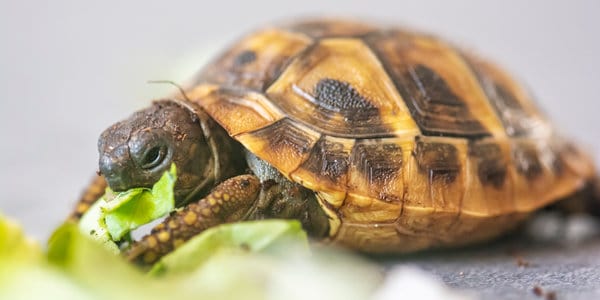
Quick Facts
Ideal for: Beginners
Scientific Name: Testudo hermanni
Lifespan: 50 years
Adult Size: 5-7 inches
Diet: Herbivore diet including greens and weeds
Considered a low-maintenance pet, Hermann’s tortoise is a popular tortoise species preferred by many pet owners. They have attractive patterns and unique personalities.
The Hermann’s tortoise is the hardest and one of the smallest tortoise species, with lengths ranging from five to seven inches.
These tortoises are native to the Mediterranean area and have several subspecies, including Dalmatian, the Eastern (largest of the species). The Western Hermann’s nicknamed the Italian tortoise and often mistaken for the Greek tortoise.
Hermann’s tortoise has an active life and is not shy around humans. If you have gentle kids with pets, Hermann’s tortoise can make a great companion thanks its small size.
They have similar housing needs as other tortoises, although there seems not to be an agreed sizing for their enclosure. Therefore, offer them an expansive outdoor enclosure to allow them to move, burrow, and hide. Indoors, invest in a tortoise table.
Maintain a good temperature range for your pets (70-85 degrees Fahrenheit in their enclosure and 90-95 degrees Fahrenheit in their basking spot. Provide a UVB light for 12 hours a day.
If you were to keep two or more Hermann’s tortoises, have separate enclosures where you can put the most aggressive one in case a fight erupts. They can be aggressive with each other sometimes.
Overall, they make good pets for both beginners and veteran keepers.
7. The Marginated Tortoise
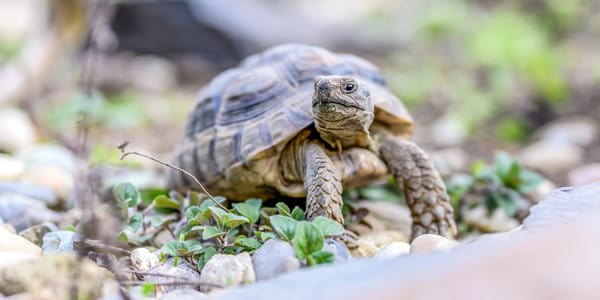
Quick Facts
Ideal for: Beginners
Scientific Name: Testudo marginata
Lifespan: 100 to 140 years
Adult Size: 12 to 15 inches
Diet: Leafy greens
Native to Sardinia, Greece, and Italy, Marginated tortoises make good pets to many, thanks to their activeness and moderate size. They got their name from their saw-like scutes that project from the back of the carapace.
They are the biggest tortoise species in the European region, reaching lengths of up to 14 inches. As they mature, their carapace turns near black with pale-yellow markings.
Since their native habitat is as high as 5,200 ft., where the environment is frigid and dry, their dark-colored shell helps them absorb the little sunlight they get to raise their body temperature.
When it gets frigid, such as during winter, Marginated tortoises hibernate to survive. When in captivity, Marginated tortoises do well in outdoor enclosures. An enclosure for the Marginated tortoise would be fifteen by twenty-five feet. Since these live in naturally rocky areas, they tend to climb and dig. Therefore, ensure their walls go at least six feet under the surface and height of 12-18 inches above the ground.
In terms of care, you shouldn’t worry too much about it during winter as long as you have provided plenty of hiding options. The Marginated tortoise is a hardy creature and can survive the coldest winter months as long as you prepare it well.
They can grow up to 12-15 inches, with females being larger than their male counterparts. Overall, they have an ideal size – not too big and not too tiny. Therefore, ensure the tortoise has ample space in its enclosure, complete with heating and UVB lights.
This tortoise eats leafy greens and commercial-produced diets. Include cacti in their diet for added roughage.
They can co-exist with other tortoises and can live for over a century. Their medium size and activeness make them excellent pets.
8. The Red-Footed Tortoise
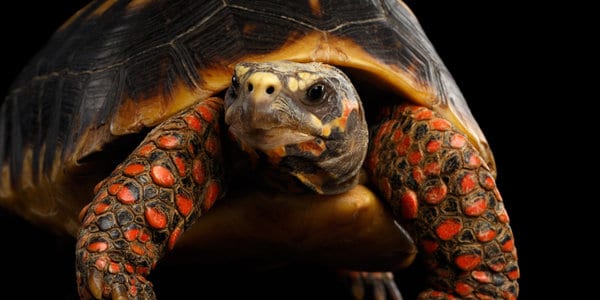
Quick Facts
Ideal for: Beginners and experienced reptile keepers
Scientific Name: Chelonoidis carbonarius
Lifespan: Over 50 years
Average Adult Size: 11-14 inches
Diet: Herbivore diet including vegetables, insects, and fruits
The Red-footed tortoise is easy to keep and can grow to attain a carapace length of 11 to 14 inches for the females, making them moderately-sized creatures.
They got their name from the red spots on their feet. Native to South America, these tortoises have shown they can survive in North America as well.
In captivity, this tortoise can live for more than fifty years and thus certainly will be your lifelong friend should you get it as a pet. Keep their enclosure heated on one side and cooler on the other to allow them self-regulate their body temperature.
Their diet is much similar to other tortoises, with the only difference being that they need more calcium as their body is majorly made of half shell and half bone. Therefore, make sure to supplement with calcium and phosphorous.
Dandelion greens, celery, parsley, watercress, kelp, and collard are all great additions to their daily diet. Feed them an all-vegetable diet with additions of insects and fruits in small amounts.
9. The Leopard Tortoise
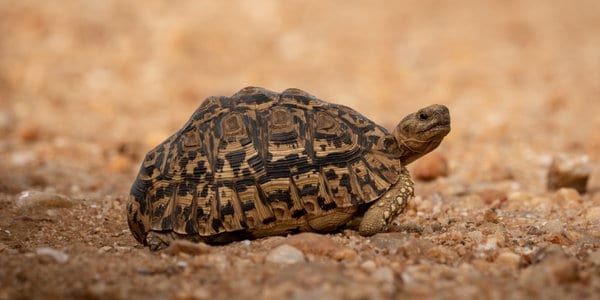
Quick Facts
Scientific Name: Stigmochelys pardalis
Adult Size: 18 inches on average
Lifespan: Can live between 50 to 100 years
Diet: Hay, thistles, and succulents
The Leopard Tortoise is the 4th largest tortoise species and is a popular pet among homeowners. They got the name from their adorable, spotted pattern that resembles a leopard. This spotted pattern is one of the factors for their popularity in captivity.
Native to the dry savannas of eastern and southern Africa, the leopard tortoise primarily feeds on dry grass and succulents.
They attain 18 inches in length and thus might not be the best candidate for indoor enclosures. If you have to keep them indoors, make sure they have a floor space of at least 50 square feet and provide adequate lighting and heating.
Their native habitat does not experience winter, and thus you should maintain their outdoor temperature above 80 degrees Fahrenheit during day time and 75 degrees Fahrenheit at night.
Leopard tortoises do not burrow or climb, and thus an 18-inch tall wall should be ideal for their enclosure.
Another thing is that they are not territorial, which means you can keep multiple Leopard tortoises of both sexes in one enclosure. Just remember to have ample space for all of them should you decide to keep several individuals in one enclosure.
Overall, the leopard tortoise is a fun pet and can get big. As a result, be ready to provide ample space for them.
10. African Sulcata Tortoise
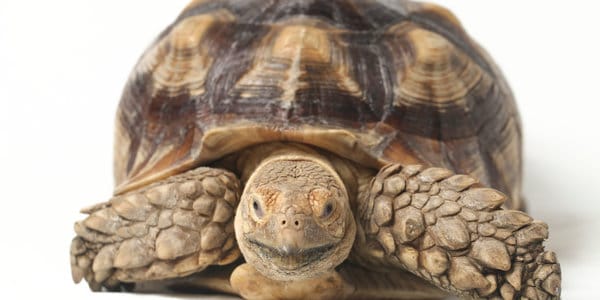
Scientific Name: Centrochelys sulcate
Common Names: African spur thigh tortoise, African spurred tortoise, spurred tortoise.
Lifespan: Over 70 years
Adult Size: 33 inches
Ideal for: Intermediate and Experienced reptile keepers
Diet: Grass, flowers, and weeds
The African Sulcata tortoise is surprisingly adaptive, making it one of the most popular pets in North America. While hatchlings can be 1.5-2 inches in length, adults can attain a carapace length of up to 33 inches and weigh over 200 pounds.
Due to their enormous size, it’s best to house the African Sulcata tortoise outdoors in a big yard where they can explore. Keeping them in the indoor enclosure is not advisable.
They tend to burrow, and thus you need to ensure their enclosure is at least two feet deep and two feet tall. Don’t out transparent walls or mesh fences as they have a hard time understanding barriers and thus will try to go through the mesh, leading to injuries.
Make sure the tortoise has access to sunlight. Although they can survive temperature drops, it is ideal to bring them indoors if the temperatures fall below 45 degrees Fahrenheit.
Rescuing a Sulcata tortoise and giving the big fella a good home is recommended over buying delicate hatchlings. Many people purchase the babies and later get rid of the tortoise when it is too big for them to handle.
The Sulcata tortoise can live for more than 70 years, but there is no valid information regarding the maximum lifespan a Sulcata can live.
If you’re a first-time tortoise owner and have a big yard where you can keep this big boy, the Sulcata can be a fantastic choice. They are friendly and have a sweet personality.
Ensure the walls of their yard are sturdy as the Sulcata tortoise is more like a tiny bulldozer and thus will knock down things in its patch.
Although it can be challenging to carry due to their weight, when it’s time to relocate it or take it to a vet, they are easy to handle as long you can lift them. The good thing is that they’re unlikely to bite.
They eat grass constantly, and thus you should be prepared to provide them with grass, hay, and succulents. It’s important to mention that their fecal matters can be pretty big, and thus you should not be alarmed by this.
Overall, the Sulcata tortoise can seem too big and scary to be kept as pets, but they tend to be hardy and adaptive. They are not aggressive, and thus if you are up to the task of caring for these creatures, you’ll have yourself a gentle giant by your side for a lifetime.
Other Tortoise Species You Can Keep as Pets
Elongated Tortoise
The most defining feature of this species is its elongated shell, which makes it take an oval shape.
Averagely, an adult elongated tortoise can grow their carapace up to 14 inches, making them moderate creatures in terms of size. Females are often wider and more rounded than their male counterparts, but they still take the oval shape the species is best known for.
Native to the tropical forests in Asia, these species have a different way of life than many other pet tortoises – they don’t enjoy direct sunlight. Instead, you’ll find them wallowing in leaf litter and basking under plant shade.
They are pretty challenging to care for as you have to create the right humidity and temperature gradient. Their enclosure should have separate zones (a humid zone for cooling off their bodies and a dry zone for raising their body temperature). This means you’ll need to provide a long enclosure.
Overall, they are good pets for experienced reptile keepers.
Burmese Mountain Tortoise
The Burmese Mountain Tortoises are native to Sumatra, Thailand, and Malaysia and have become endangered due to over-exporting. They can reach carapace lengths of up to two feet and can weigh up to 100 pounds.
As adults, Burmese mountain tortoises are easy to care for as they often feed on virtually everything you throw at them. However, their large size presents a different challenge to new owners – they can be too big to handle and become intimidating.
They are best kept in outdoor enclosures due to their size. The good thing is that they are not territorial and thus can stay in pairs or groups.
Yellow-footed Tortoise
Like the red-footed tortoise, this tortoise got their name from its yellow feet. Although the yellow color is not intense, it doesn’t mean they are less beautiful.
They have tall shells, and their carapace has ridged scutes, which feature a darker edge with a light tan center. They have yellow-like tan color on their skin, making them visually attractive compared to the usual dark-brown skin that most tortoises have.
They can grow to reach carapace lengths of about 14 inches, with some species reaching 28 inches in length. This means you need to be prepared to handle giant pets should you get one.
They’re herbivorous and thus will eat plant-based foods, although they may need high-protein snacks severally a month.
Conclusion
Tortoises are fascinating creatures and will bring a bundle of joy to your home. However, it would be best to spend some time researching the right breed for your needs as some tend to grow as big as two feet while others remain small. Also, some breeds need more care than others.
At the end of the day, it narrows down to your preference and the size of your enclosure, as tortoises require considerable space for their movement.
We hope that you’re now in a better position to choose your next pet with this article.